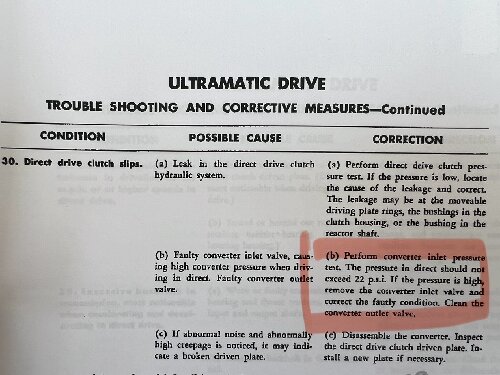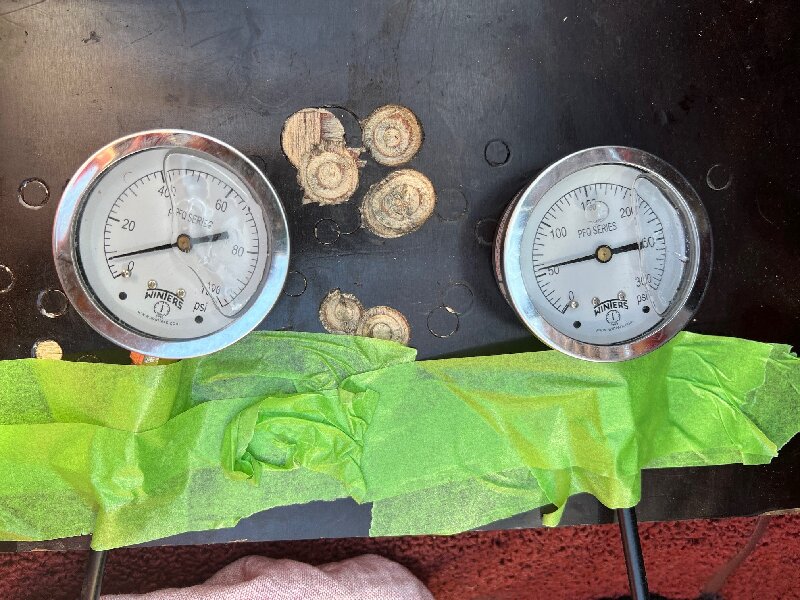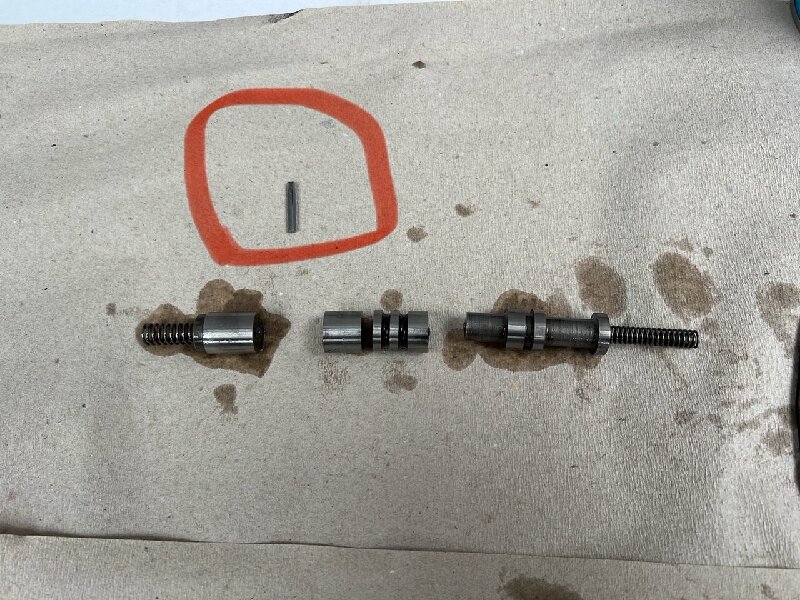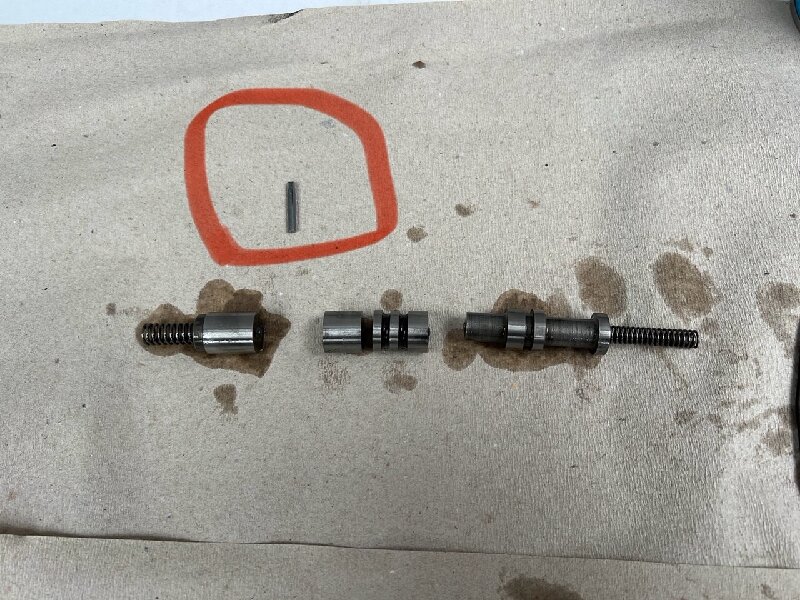|
Ultramatic gearbox problem slipping direct drive clutch
|
||||
|---|---|---|---|---|
|
Just popping in

|
Hello,
I'm George from Austria and have the following problem with my Ultramatic gearbox. After I got my 1951 250 convertible with Ultramatic gearbox out of the winter garage, I noticed that the direct drive clutch in the gearbox was slipping. I have now checked the oil level and the setting of the throttle valve lever and found no fault. According to Ultramatic drive trouble shooting and corrective measures, I have carried out the following hydraulic tests: - Front pump regulated pressure test, OK - Hydraulic governor pressure test, OK - Direct drive clutch pressure test, OK During the converter inlet pressure test, I noticed that the pressure in the converter does not drop to max. 22 psi in direct gear and with the clutch engaged, as described in point 30b on page 46 of the Ultramatic workshop manual, but only drops from 70 to 55 psi (see attached photos). It says to check the converter inlet valve and clean the converter outlet valve. Now I have the following questions: where is the converter outlet valve located, I can find it on the sequence of hydraulics operations, but I can't find it on my transmission? Where exactly is the converter inlet valve located and what could be the fault? Is it possible to remove the hydraulic unit when the transmission is installed or is that not possible? I'm in a hurry as I'm starting next weekend at the Ennstal Classic, a very demanding classic car rally in the Alps! I hope you can help me here! Many thanks and best regards from Austria George  Attach file:  car driving in H direct drive clutch disengaged, left clutch pressure right converter inlet pressure.jpg (869.64 KB) car driving in H direct drive clutch disengaged, left clutch pressure right converter inlet pressure.jpg (869.64 KB)  Ultramatic.zip Size: 2,715.00 KB; Hits: 59 Ultramatic.zip Size: 2,715.00 KB; Hits: 59
Posted on: 2024/7/6 7:48
|
|||
|
||||
|
Re: Ultramatic gearbox problem slipping direct drive clutch
|
||||
|---|---|---|---|---|
|
Home away from home
|
Hello,
If you jack the car in the air, you can drain the transmission fluid then remove the pan. I would advise buying a new pan gasket if yours is the original cork as it probably won't seal well when re-attached. Also on replacement, be sure to follow the torque spec which I think is 11 ft lbs. Once the pan is off you can take some thin pieces of sheet metal and stick them above the two pistons. Just cut to size and drill a hole in it to mount on a pan bolt hole. This is explained on p. 27 of this:packardinfo.com/xoops/html/modules/archive/content.php?ContentID=49 Then take the pistons and valve body off. Disassemble the upper valve body and inspect all the valves and springs. See page 12 of your service manual. The converter outlet valve was simply deleted in the later first gen Ultramatics, so yours may not even have one. If you do, since your pressure is too high, yours may have some problem. First see if there is any problem in the upper valve body, as the converter inlet valve / relief valve could cause this problem if it sticks; it would supply full pressure even when the direct circuit is engaged. If you reassemble after service and nothing changed, you may want to try the outlet valve modification here:packardinfo.com/xoops/html/downloads/STB/50T-61.pdf You may also want to blow some compressed air through your cooler lines to check for obstructions. Just set the pressure to no higher than 15 PSI so there is no chance to hurt the cooler. You asked which valve is which. Please see starting on p. 15 in my link above. Also see these charts:packardinfo.com/xoops/html/modules/newbb ... ?attachid=1697223399&post_id=262827 Overall, I think it's most likely that your converter inlet valve is sticking or there is a problem thereabouts.
Posted on: 2024/7/6 9:04
|
|||
|
1955 400 | Registry | Project Blog
1955 Clipper Deluxe | Registry | Project Blog 1955 Clipper Super Panama | Registry Email (Parts/service inquiries only, please. Post all questions on the forum.) service@ultramatic.info |
||||
|
||||
|
Re: Ultramatic gearbox problem slipping direct drive clutch
|
||||
|---|---|---|---|---|
|
Forum Ambassador
|
Also check out the article starting on page 11 about the new torque converters for 52. Your 51 probably has the original design but could have the new style direct drive clutch converter if problems developed in the splines on the old style driving piston plate. If yours is still original the article mentions splines causing problems on release but as I recall there are other articles saying problems with DD engagement could be an issue if the splines on the DD plate were sticking or had developed wear or gouges.
Posted on: 2024/7/6 9:27
|
|||
|
Howard
|
||||
|
||||
|
Re: Ultramatic gearbox problem slipping direct drive clutch
|
||||
|---|---|---|---|---|
|
Just popping in

|
Hello Humanpotatohybrid,
Thank you very much for your help and good tips. I did it and removed and checked the control unit this morning. The pin between the converter inlet valve and the converter relief valve has come loose and was in the oil pan. It was probably inserted the wrong way round. This evening I went for a test drive. The gearbox is ok again and the direct drive clutch shifts as it should! Best greetings from Austria. George PS: In the Packard Service Technician Training Book on page 24 it says about Shifting from Low Range to High Range and from High Range to Low. I always thought you shouldn't shift the Ultramatic from Low to High or vice versa while driving, because the transmission wasn't built for that and if it becomes defective?Quote:
Attach file:  converter inlet valve and converter relief valve with loosen pin.jpg (394.63 KB) converter inlet valve and converter relief valve with loosen pin.jpg (394.63 KB)  converter inlet valve and converter relief valve with loosen pin.jpg (394.63 KB) converter inlet valve and converter relief valve with loosen pin.jpg (394.63 KB)
Posted on: 2024/7/7 16:03
|
|||
|
||||
|
Re: Ultramatic gearbox problem slipping direct drive clutch
|
||||
|---|---|---|---|---|
|
Home away from home
|
Hello George,
Glad to hear my diagnosis was spot-on. It isn't always! And good that you are up and running again before the big event. I suspect that the direct drive circuit was shorting to the converter relief circuit because of the missing pin, while at the same time blocking the relief circuit vent port. The consensus is generally that as long as the transmission is in good condition and adjusted properly, you should be able to shift from low to high and back. Especially on the low to high shift you should get off the throttle so that the engine does not flare up. The high to low shift you can let the engine flare up a little, so it will rev-match on Low engagement. You may wish to experiment and find what patterns result in smooth shifts with neither flaring nor the revs dropping too low. Shifting while driving is not necessary except in limited circumstances like driving up or down large, long hills that can't be done in direct drive (up) or there is insufficient engine braking in high gear (down). You may wish to review #16–20 on the troubleshooting section which details how and what can go wrong on manual shifting.
Posted on: 2024/7/7 16:48
|
|||
|
1955 400 | Registry | Project Blog
1955 Clipper Deluxe | Registry | Project Blog 1955 Clipper Super Panama | Registry Email (Parts/service inquiries only, please. Post all questions on the forum.) service@ultramatic.info |
||||
|
||||
|
Re: Ultramatic gearbox problem slipping direct drive clutch
|
||||
|---|---|---|---|---|
|
Forum Ambassador
|
Quote:
PS: In the Packard Service Technician Training Book on page 24 it says about Shifting from Low Range to High Range and from High Range to Low. This shift between gears is something Packard worked on several times during the life of the original Ultramatic because as transmissions from other mfgs became available they found themselves somewhat at a competitive disadvantage. The shift is possible in theory as Packard described it -- providing all the conditions are exactly the same each time it is done. In practical fact if done carefully and not under a lot of power it can be done safely and reliably. The issue starts when one driver might have the engine running wide open when he does the shift while another might not. One driver might move between gears as fast as he can while another moves slower. Of course, sometimes improper adjustment of the throttle rod thwarted even the best of intentions in shift actions. The original low high shift valve design and single pin as a restriction to slow down oil flow just didn't seem to work very well under all conditions. Thruout production Packard changed the restriction pin size and then the valve design, then different springs, and then the restriction size again all in efforts to better fine tune the low-high timing. While it was improved it was never completely successful to the point of being a reliable shift under all drivers and conditions. The 54 GS and later Twin Ultras were designed for this operation but even the GS and early 55 units had some of the same issues. Thru 55 they worked on some of the timing and pressure issues and finally got the throttle rod positioning and some of the valve design and spring combos more in sync. By 56 production they had things working fairly well. Most all of the later changes were applied to the earlier gear start and 55 units to improve their operation.
Posted on: 2024/7/7 17:00
|
|||
|
Howard
|
||||
|
||||
|
Re: Ultramatic gearbox problem slipping direct drive clutch
|
||||
|---|---|---|---|---|
|
Home away from home
|
George, thank for the updates on what you found and good job on getting it sorted out. I'm glad you found the issue and were able to get it repaired in time for your rally in the Alps! Post some pictures of the rally if you have a chance!
I agree with Howard, that while the Ultramatics were designed to be shifted from Low to High, there were issues. I use High all the time, I might use low if I was plowing a field!  I think ensuring your throttle valve linkage is adjusted correctly, so your direct drive isn't engaging too soon, provides plenty of get up and go in most circumstances. If you're shifting from Low to High, under heavy load and too aggressively, you may find that your Ultramatic will become a Problamatic! I think ensuring your throttle valve linkage is adjusted correctly, so your direct drive isn't engaging too soon, provides plenty of get up and go in most circumstances. If you're shifting from Low to High, under heavy load and too aggressively, you may find that your Ultramatic will become a Problamatic! 
Posted on: 2024/7/7 20:42
|
|||
|
||||
|
Re: Ultramatic gearbox problem slipping direct drive clutch
|
||||
|---|---|---|---|---|
|
Home away from home
|
Quote:
That's the thing. You can't shift from low to high "under load" in a first gen Ultramatic. No way José. Unless you want your high range clutches to end up resembling that marshmallow you dropped in the campfire as a kid. 😂 By the way George, it's good you did the pressure test. Without it, I would have suggested that your converter bushings are worn out, as that's a common issue that causes this problem. That would have sent you in the whole wrong direction. Of course, if one is to read the factory literature, this point was emphasized heavily. One anecdote they gave was a car that had several transmission parts replaced, and even the carburetor rebuilt (keep in mind this was a nearly new car), only to find after the pressure tests, some leakage in the reverse servo causing low overall pump pressure and hence the various symptoms. A new servo and pair of tubes and it worked good as new.
Posted on: 2024/7/7 21:34
|
|||
|
1955 400 | Registry | Project Blog
1955 Clipper Deluxe | Registry | Project Blog 1955 Clipper Super Panama | Registry Email (Parts/service inquiries only, please. Post all questions on the forum.) service@ultramatic.info |
||||
|
||||








